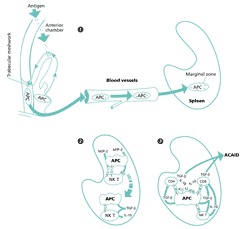

Injection of antigen into the anterior chamber of the eye leads to the development of a systemic immune response that is deviant and unexpected. This response, termed anterior chamber-associated immune deviation (ACAID), represents a selective, antigen-specific deficit of T cells that mediate delayed hypersensitivity and B cells that secrete complement-fixing antibodies, i.e. immune effectors that trigger immunogenic inflammation. The selective deficiency of ACAID is due to the generation of antigen-specific regulatory T cells (CD4+ and CD8+) that inhibit both induction and expression of pro-inflammatory effector modalities. At the same time, these regulators have no effect on other effector modalities, leaving cytotoxic T-cell responses and non-complement-fixing antibodies intact.
Factors within the eye play a key role in the generation of ACAID. APC indigenous to the eye (stroma of iris and ciliary body) express CD1 and are heavily influenced by soluble molecules in the ocular microenvironment, especially transforming growth factor-beta2 (TGF-beta2). When these cells capture local antigen, they display the capacity to process and present peptides on class I and II MHC molecules, and they even express certain costimulatory molecules (B7-1). However, they fail to secrete IL-12 and they are impaired in their ability to upregulate expression of CD40 – costimulatory molecules that are central to the induction of T cells that mediate delayed hypersensitivity. In addition, eye-derived APC secrete active TGF-beta2. This is the distinct functional phenotype of antigen-bearing APC that leave the anterior chamber by migrating across the meshwork directly into the venous circulation (fig. 2). Traversing the bloodstream, eye-derived APC migrate preferentially to the marginal zone of the spleen where they secrete MIP-2, a chemokine that attracts NK T cells. The latter cells bear a special T-cell receptor that recognizes CD1. When APC-NK T-cell conjugates form, the NK T cells secrete additional chemokines which bring to the site antigen-specific T cells. From this multicellular aggregate emerge the regulatory T cells of ACAID.
The importance of ACAID to ocular immune privilege is that it pre-empts the systemic immune response to eye-derived antigens, molding all subsequent responses to the same antigens such that inflammation doesn't develop when these antigens are encountered within the eye (or anywhere else for that matter). The ocular factors that conspire to produce this form of tolerance are: (a) TGF-beta2, which endows ocular APC with special costimulatory properties, and (b) an outflow path for aqueous humor (AqH) that directs mobile antigen-bearing APC directly to the blood (rather than into the lymphatics) and therefore to the spleen. It is the spleen that presides over the inductive events that lead to ACAID. In animals devoid of a spleen, ACAID fails to develop.
The Eye's Dilemma
Immune Privilege
Anterior Chamber of the Eye as an Immune- Privileged Site
Inflammation of Relation to Innate and Adaptive Immune Responses
Ocular Factors That Promote Immune Tolerance of Eye-Derived Antigens
Factors That Modify Expression of Ocular Adaptive Immunity
Innate Immune Privilege in the Eye
Factors That Modify Expression of Innate Ocular Immunity
Clinical Meaning of Ocular Immune Privilege
Selected Reading
Biography
>> next
